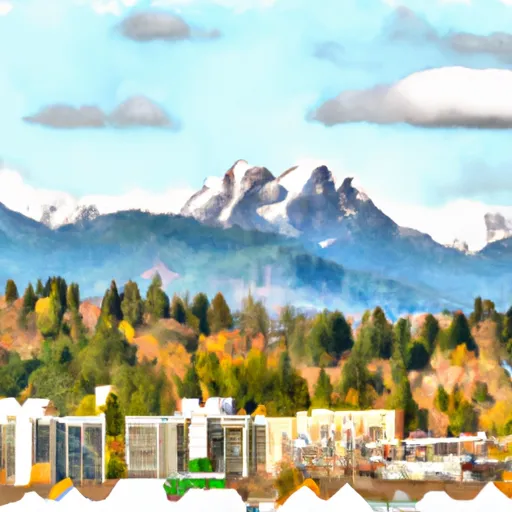-
 Snoflo Premium
Snoflo Premium
Get unlimited access to all our content
With no Ad interruptions! - Start Your Free Trial Login with existing account
Snoqualmie
Eden Index
Climate
8.6
•
Recreation
3.8
•
Community
5.7
•
Safeguard
6.2/10

Snoqualmie is a small city located in King County, Washington. It is nestled in the western foothills of the Cascade Mountains, offering a unique climate and abundant outdoor recreation opportunities. The region experiences a temperate maritime climate with mild, wet winters and warm, dry summers. The average annual rainfall is around 60 inches, and snowfall is common in the winter months.
Snoqualmie benefits from its proximity to the Snoqualmie River, which flows through the city. The river is fed by several smaller tributaries, contributing to the hydrology of the area. These water sources provide opportunities for fishing, kayaking, and rafting. Additionally, Snoqualmie Falls, a stunning 270-foot waterfall, is a prominent feature and a popular tourist attraction.
Outdoor enthusiasts will find numerous recreation opportunities in Snoqualmie. The city is surrounded by beautiful forests, offering hiking and mountain biking trails for all skill levels. The nearby mountains provide opportunities for skiing, snowboarding, and snowshoeing during the winter months. Snoqualmie is also home to several parks and golf courses, perfect for picnicking, camping, or a round of golf.
In conclusion, Snoqualmie, Washington, offers a mild, wet climate, a vibrant hydrology system, and abundant outdoor recreation opportunities. From enjoying the picturesque Snoqualmie Falls to exploring the surrounding forests and mountains, this charming city has something to offer for nature lovers and adventure seekers alike.
What is the Eden Index?
The Snoflo Eden Index serves as a comprehensive rating system for regions, evaluating their desirability through a holistic assessment of climate health, outdoor recreation opportunities, and natural disaster risk, acknowledging the profound impact of these factors on livability and well-being.
Climate Health Indicator (CHI): 8.6
Snoqualmie receives approximately
1616mm of rain per year,
with humidity levels near 65%
and air temperatures averaging around
10°C.
Snoqualmie has a plant hardyness factor of
8, meaning
plants and agriculture in this region tend to thrive here all year round.
By considering the ideal temperature range, reliable water supplies, clean air, and stable seasonal rain or snowpacks, the Climate Health Indicator (CHI) underscores the significance of a healthy climate as the foundation for quality living.
A healthy climate is paramount for ensuring a high quality of life and livability in a region, fostering both physical well-being and environmental harmony. This can be characterized by ideal temperatures, reliable access to water supplies, clean air, and consistent seasonal rain or snowpacks.
Weather Forecast
Streamflow Conditions
Puget Sound
Area Rivers
Puget Sound
Snowpack Depths
Puget Sound
Reservoir Storage Capacity
Puget Sound
Groundwater Levels
Recreational Opportunity Index (ROI): 3.8
The Recreational Opportunity Index (ROI) recognizes the value of outdoor recreational options, such as parks, hiking trails, camping sites, and fishing spots, while acknowledging that climate plays a pivotal role in ensuring the comfort and consistency of these experiences.
Access to outdoor recreational opportunities, encompassing activities such as parks, hiking, camping, and fishing, is crucial for overall well-being, and the climate plays a pivotal role in enabling and enhancing these experiences, ensuring that individuals can engage in nature-based activities comfortably and consistently.
Camping Areas
| Campground | Campsites | Reservations | Toilets | Showers | Elevation |
|---|---|---|---|---|---|
| Kanaskat Palmer Recreation Area | None | 884 ft | |||
| Tolt MacDonald Park | 40 | 67 ft |
Nearby Ski Areas
Catastrophe Safeguard Index (CSI):
The Catastrophe Safeguard Index (CSI) recognizes that natural disaster risk, encompassing floods, fires, hurricanes, and tornadoes, can drastically affect safety and the overall appeal of an area.
The level of natural disaster risk in a region significantly affects safety and the overall livability, with climate change amplifying these risks by potentially increasing the frequency and intensity of events like floods, fires, hurricanes, and tornadoes, thereby posing substantial challenges to community resilience and well-being.
Community Resilience Indicator (CRI): 5.7
The Community Resilience Indicator (CRI) recognizes that education, healthcare, and socioeconomics are crucial to the well-being of a region. The CRI acknowledges the profound impact of these elements on residents' overall quality of life. By evaluating educational resources, healthcare accessibility, and economic inclusivity, the index captures the essential aspects that contribute to a thriving community, fostering resident satisfaction, equity, and social cohesion.

